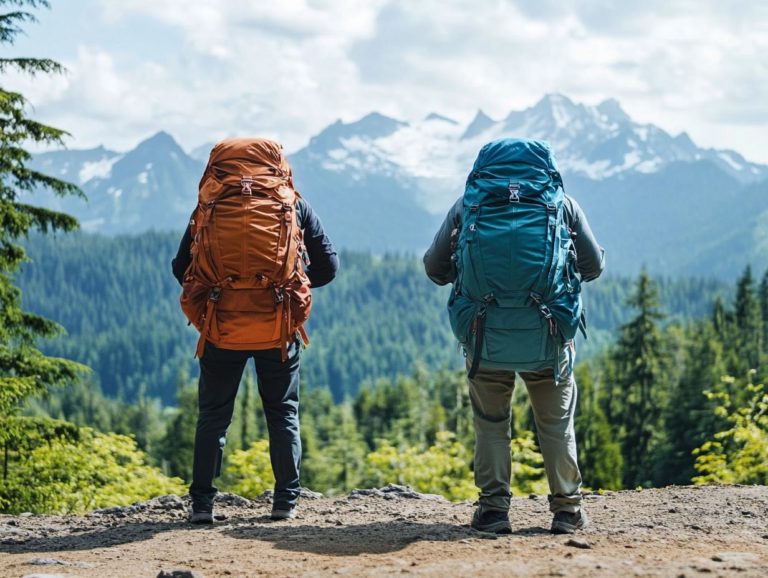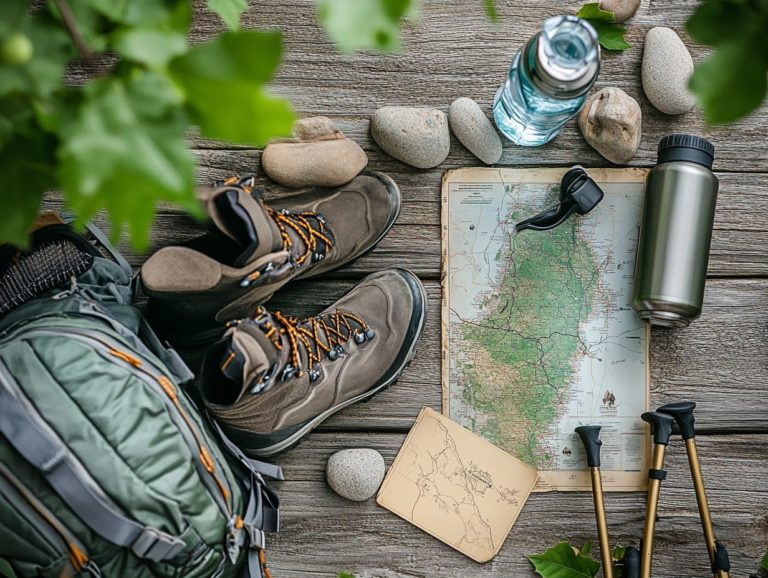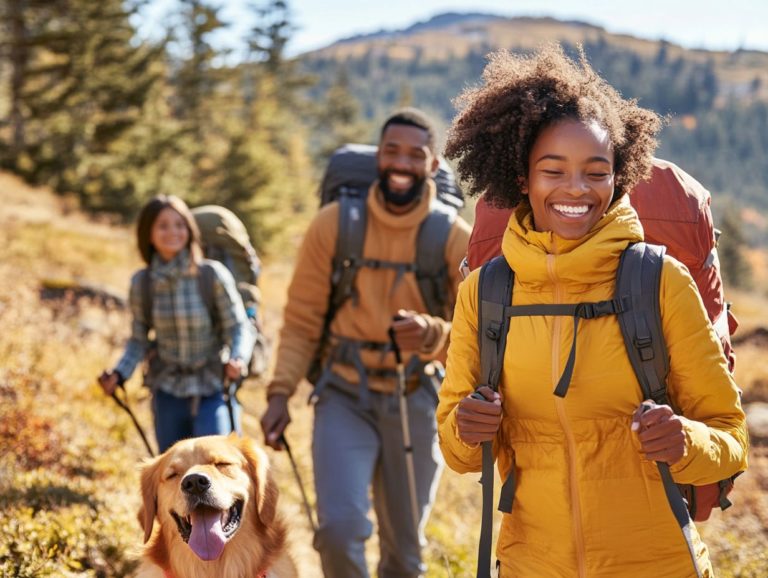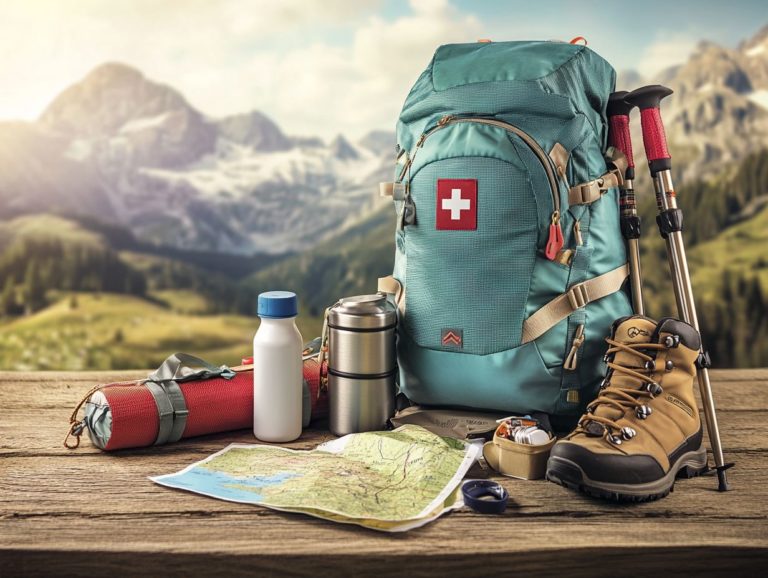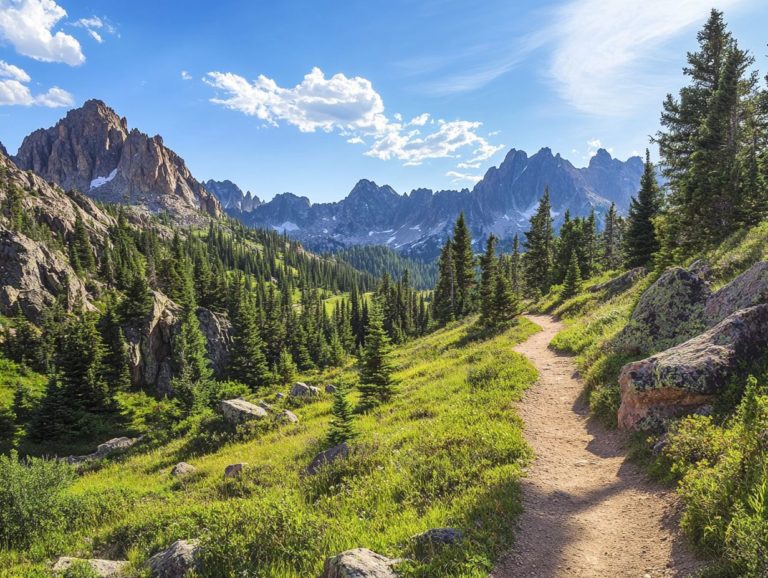What to Pack for a Day Hike
Planning a day hike can be an exhilarating experience, but ensuring you have the right hiking essentials is very important for a safe and enjoyable adventure.
From selecting the perfect hiking shoes and attire to packing vital essentials in your lightweight daypack, every detail plays a significant role. Get ready! This guide reveals everything you need to know about what to bring, along with hydration and nutrition tips to keep your energy levels up.
You’ll also discover navigation tools, safety equipment, and additional items that can enhance your experience in the great outdoors. Whether you re a seasoned hiker or just starting out, this guide serves as your comprehensive resource for a successful day on the trails.
Contents
Key Takeaways:
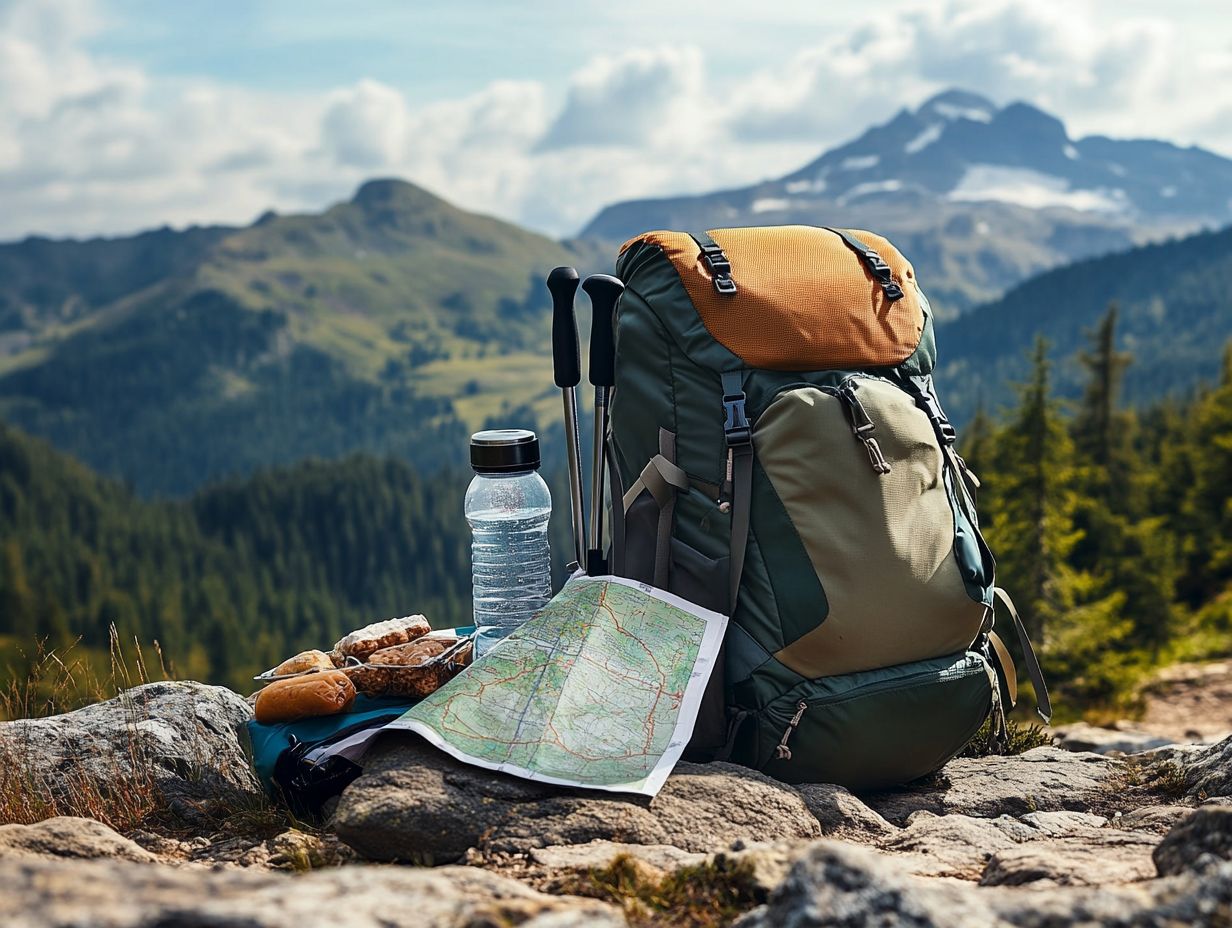
- Gear up! Invest in a good pair of hiking shoes, breathable fabrics, and comfortable clothing to protect your feet and body on a day hike.
- Stay hydrated and fueled! Pack enough water in your hydration pack a special water container designed for hiking and nutritious energy snacks. Plan for breaks to refuel and rest.
- Safety first! Always prioritize safety when hiking. Pack navigation tools like a compass and a GPS device, a first aid kit, and extra emergency gear for unexpected situations.
Essential Gear for a Day Hike
When planning your day hike, ensuring you have the essential gear is very important for both comfort and safety. The right hiking essentials can truly transform your experience, whether you re meandering through sunlit trails or braving sudden weather changes.
A well-packed bag filled with appropriate outdoor gear, including a lightweight jacket and trekking poles, can elevate your adventure significantly. It s not just about securing the right hiking shoes; you also need a lightweight jacket, a hydration pack, and essential safety gear like a first aid kit and trekking poles for that extra support.
Always prioritize comfort and preparedness to fully embrace the joy of your hike.
Hiking Shoes and Clothing
Hiking shoes and clothing are essential elements that significantly enhance your comfort and performance on the trail. By selecting the right pair of hiking shoes, like the Altra Lone Peaks or Merrell options, you ensure that your feet receive the support and protection they need against rugged terrains. Pick hiking clothes made of breathable fabrics to stay comfortable during your journey.
Well-fitted hiking shoes can profoundly influence your experience across various trails, offering stability, traction, and cushioning. Take Altra Lone Peaks, for instance; their unique footshape design lets your toes splay naturally, while Merrell shoes are known for their durability, thanks to robust materials.
Pairing these shoes with lightweight, moisture-wicking fabrics boosts your comfort, especially on longer hikes. To prepare for shifting weather conditions, layering is crucial: begin with a moisture-wicking base layer, add an insulating layer, and top it off with a waterproof shell for optimal protection.
This strategic approach maximizes your comfort and ensures you re ready for any adventure that awaits.
Backpack and Daypack Essentials
Selecting the right backpack and grasping the essentials of a daypack is crucial for your hiking success. You want a lightweight backpack that comfortably holds your hydration pack, snacks, and emergency gear without straining your back. Consider not just your food and water; make room for a portable charger for your smartphone, a camera to capture those breathtaking moments, and essential safety gear.
A well-structured daypack should ideally weigh around two to three pounds, enhancing your mobility and ease of movement. Comfort is key; padded shoulder straps and a ventilated back panel can significantly elevate your experience on the trail.
When you’re packing, include quick-access pockets for energy snacks to keep your energy levels up. Multi-tools or a first aid kit can also provide that extra peace of mind against unforeseen circumstances.
Lastly, ensure your daypack features adjustable straps to distribute weight evenly. This way, you can embark on all-day adventures without feeling the fatigue creep in.
Food and Water for a Day Hike
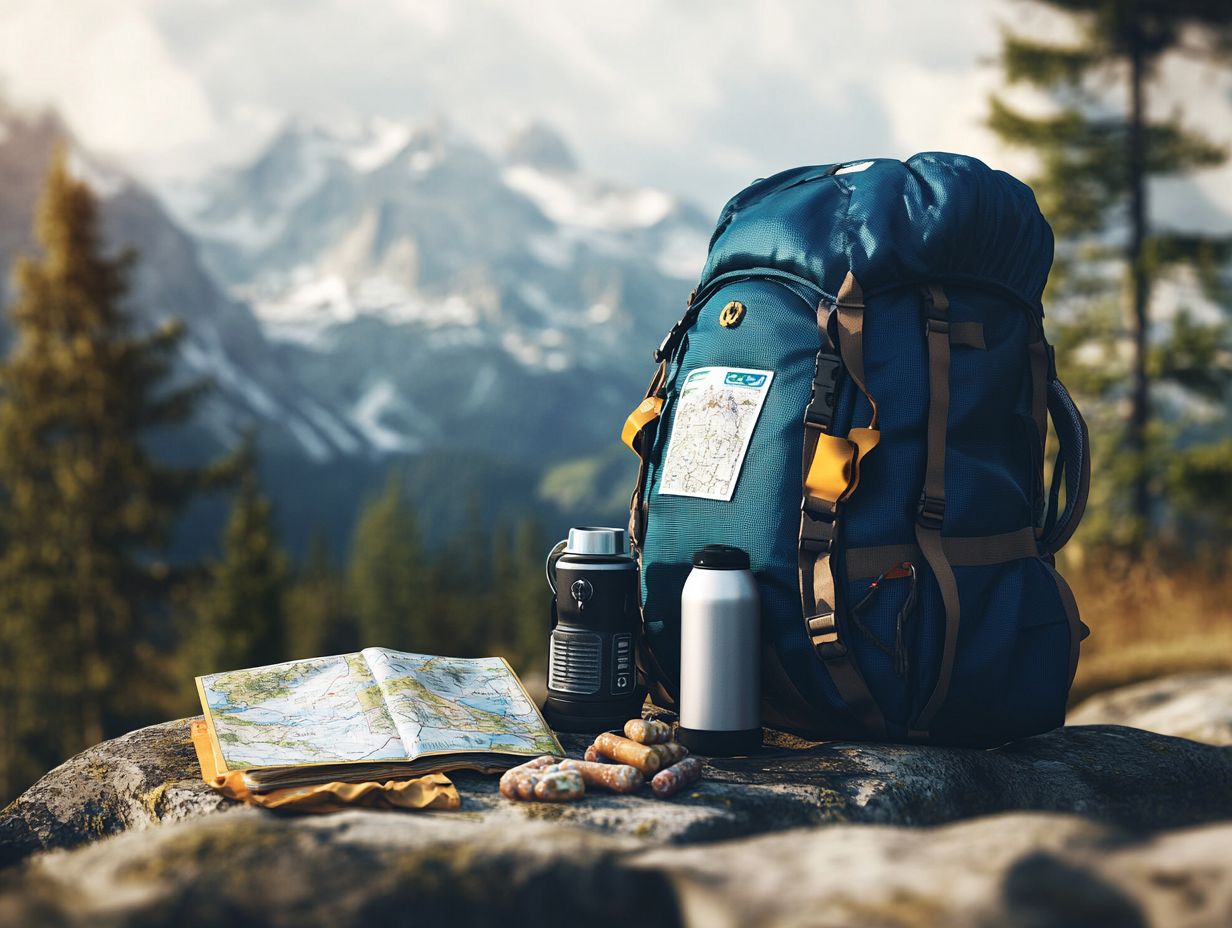
Proper nutrition and hydration are key for maintaining your energy levels and ensuring safety throughout a day hike. Carry enough water and nutritious snacks to enhance your performance and enjoyment on the trail.
Consider easy-to-carry options like energy bars and NUUN electrolyte tablets. These will help replenish lost nutrients and keep you hydrated while exploring the great outdoors.
Hydration and Nutrition Tips
Staying hydrated and nourished is essential for maximizing both enjoyment and safety. Sip regularly from your hydration pack to prevent dehydration and include energy snacks like nuts or energy bars for fuel.
Aim for about half a liter of water every hour. Adjust your intake based on the intensity of your hike and the weather. Watch for signs of dehydration, such as dark urine, dizziness, or fatigue.
Consider the nutritional value of your snacks. For example, almonds provide healthy fats, while dried fruits offer quick energy. Balance your food intake by snacking every couple of hours, and pack a lightweight stove for hot meals if needed. This will help sustain your energy levels throughout the hike.
Effective navigation and the right safety equipment are crucial for a successful day hike. They ensure both security and enjoyment during your adventure.
A reliable compass and a GPS device will guide you along the right path. A well-stocked first aid kit is critical for emergencies.
Carrying a safety whistle is invaluable in unexpected situations, providing peace of mind as you traverse the great outdoors.
Maps, Compass, and First Aid Kit
Maps, a compass, and a well-equipped first aid kit are essential for any hiking adventure. Familiarize yourself with topographic maps before hitting the trail to enhance your navigation skills.
A reliable compass helps you regain your bearings if you stray off course. Also, don’t underestimate the importance of a comprehensive first aid kit; it s essential for managing injuries or emergencies.
Learn to read contour lines on your map, as they provide insights into elevation changes that affect trail difficulty. For instance, steep slopes or valleys indicate where to plan rest stops or find safer paths.
To use a compass, align the needle with north to ensure you’re heading in the right direction, especially in dense forests where landmarks may be scarce.
Your first aid kit should include:
- Adhesive bandages – for minor cuts and scrapes.
- Antiseptic wipes – to clean wounds.
- Pain relievers – to manage discomfort.
These essentials are your ticket to a hassle-free hiking experience, ensuring a safer and more enjoyable outdoor adventure.
Additional Items to Consider
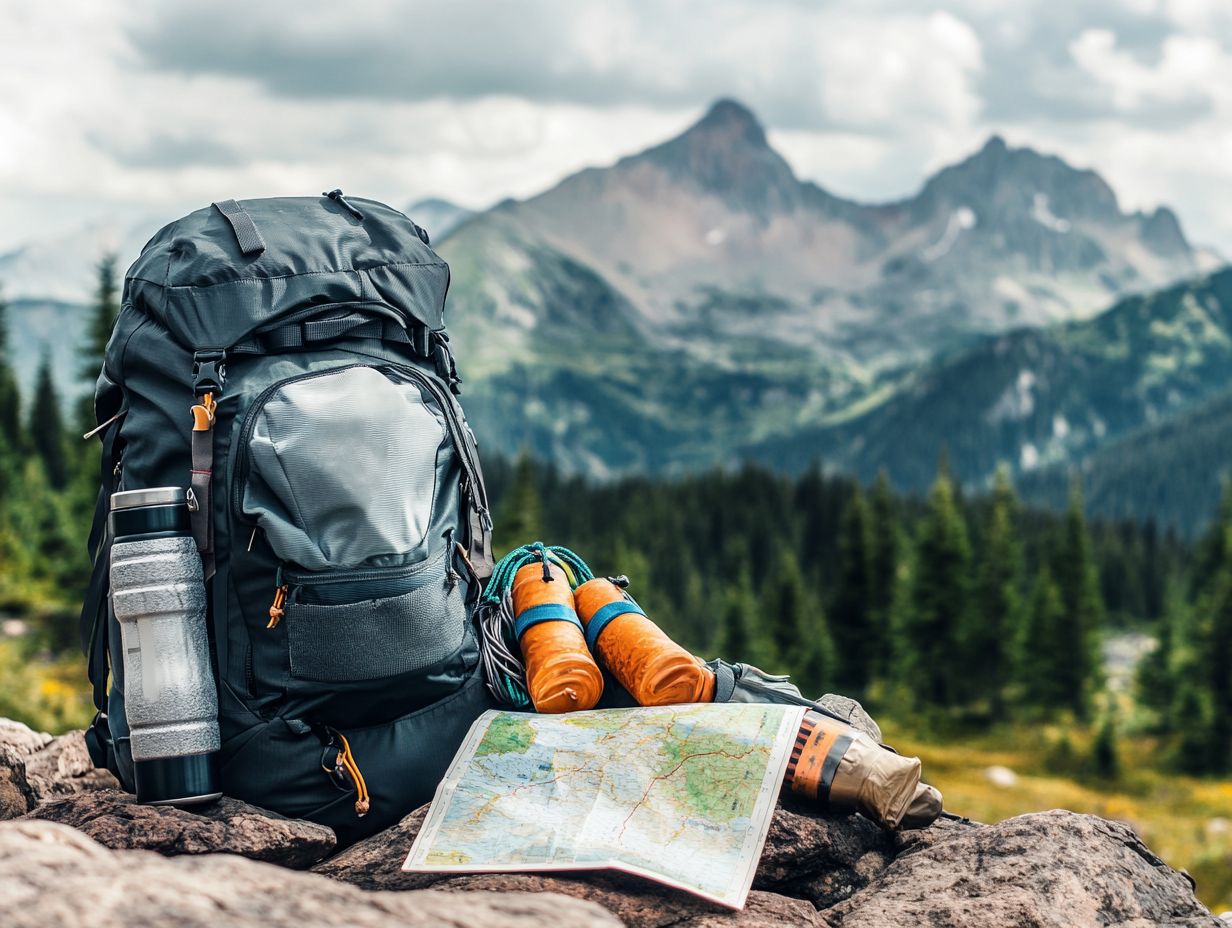
Beyond the basics, consider a few additional items to elevate your outdoor experience.
Sun protection, like high-quality sunscreen and a stylish hiking hat, shields you from harmful UV rays. Don t forget bug repellent; it’s vital for keeping pesky pests at bay.
Bringing along lightweight jackets and waterproof covers prepares you for unpredictable weather. Don t let an unexpected storm ruin your adventure!
Sun Protection and Bug Repellent
Sun protection and bug repellent are crucial elements for a successful day hike. They allow you to fully embrace the great outdoors without any discomfort.
Applying high SPF sunscreen and wearing a hiking hat can effectively shield your skin from harmful UV rays. Bug repellent keeps those pesky insects at bay during your hike.
Opt for sunscreen that protects against different types of sun rays, ideally with an SPF of 30 or higher. You ll find various options like sprays and sticks that make putting it on again a breeze while you re on the move. Have them ready in your lightweight daypack.
For bug repellent, those containing DEET a common ingredient in bug sprays that helps keep insects away or picaridin have proven effective against mosquitoes and ticks. To maximize your protection, apply sunscreen generously at least 15 minutes before stepping outside. Remember to reapply every two hours, especially after sweating or swimming.
Apply bug repellent to your skin and clothing. This will create a barrier that keeps insects away, ensuring your outdoor adventures remain enjoyable and bite-free.
Emergency Supplies
Carrying emergency supplies is essential when you set out for a day hike. It ensures you re prepared for any unforeseen circumstances that might come your way.
A multi-tool is another must-have. It provides the versatility to tackle a range of tasks, from fixing gear to whipping up a meal. Don t underestimate the importance of having a reliable source of clean water, whether it s a portable water filter or purification tablets. Staying hydrated is key to your health during any outdoor adventure.
A flashlight with extra batteries is crucial for visibility if your journey extends into the evening. Additionally, a roll of duct tape can be surprisingly handy for quick repairs. Each of these seemingly minor items can significantly enhance your safety and comfort, highlighting the importance of being thoroughly prepared for whatever challenges the wilderness may throw at you.
Frequently Asked Questions
What should I pack?
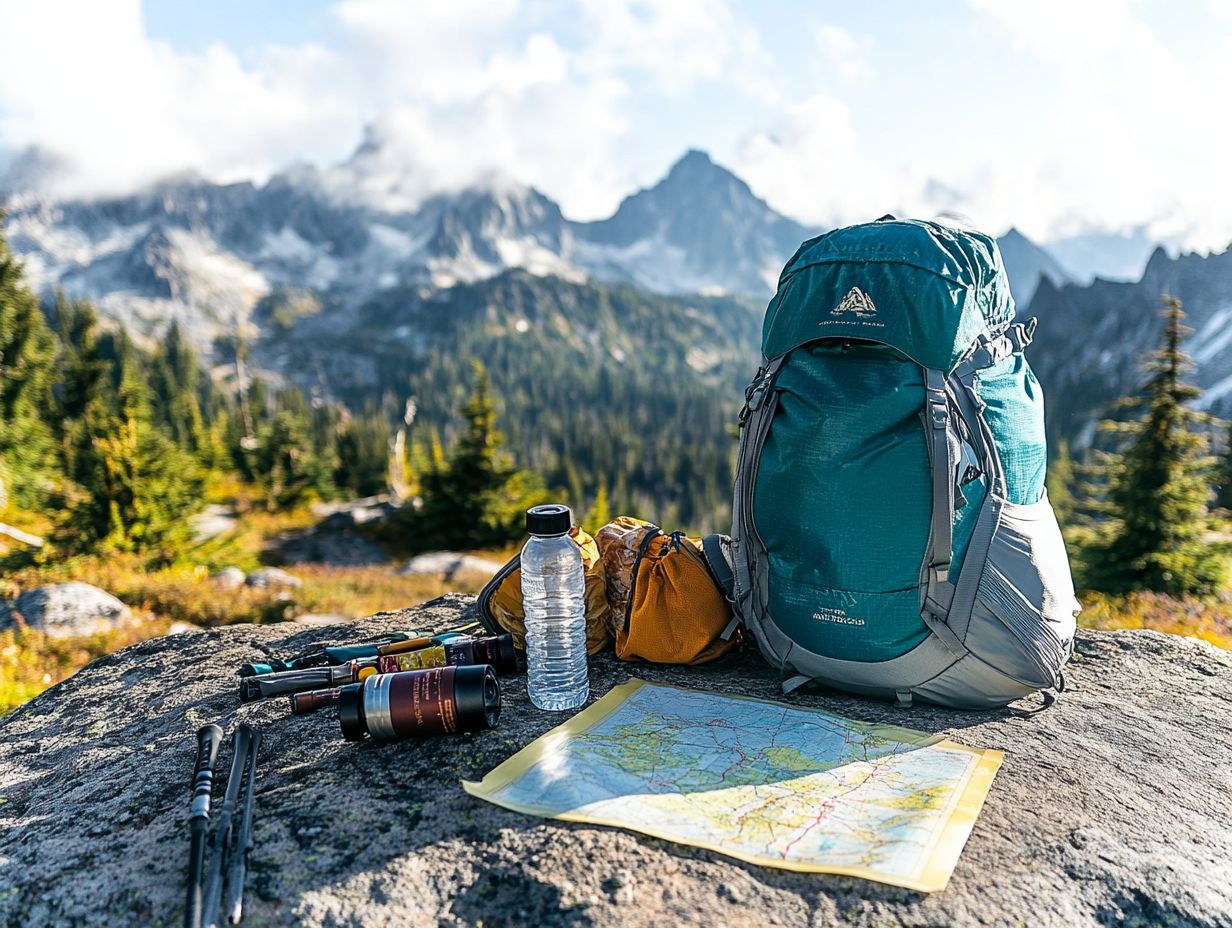
A day hike is a great way to explore the outdoors and get some exercise. To ensure a safe and enjoyable hike, it’s important to pack the right gear. Here are some commonly asked questions about what to pack for a day hike.
1. What should I wear?
For a day hike, wear comfortable, moisture-wicking materials that will keep you cool and dry. It’s also important to wear layers, as the temperature can change throughout the day. Don’t forget sturdy hiking boots or shoes!
2. What essentials should I bring?
Essential items include a map, compass, sunscreen, bug spray, first aid kit, and plenty of water. Don t forget a light snack, like energy bars or trail mix, to keep your energy levels up!
3. How much water should I bring?
Stay hydrated to keep your energy up and enjoy your adventure! It s recommended to bring at least 2 liters of water per person for a day hike. If you plan on hiking in hot weather or for longer distances, you may need to bring more water.
4. Do I need to pack extra clothing?
Even if the weather looks sunny and warm, pack a rain jacket or windbreaker. Temperatures can drop, or unexpected rain showers can occur. It s better to be prepared than caught off guard!
5. Can I bring my dog?
Many hiking trails allow dogs, but check the rules and regulations of the specific trail beforehand. If you plan on bringing your dog, pack extra water, a collapsible bowl, and any necessary leashes or waste bags.
6. Should I bring a backpack?
Yes! A backpack is essential for a day hike. It allows you to carry all your necessary gear, as well as any treasures you may find along the way. Choose a backpack that is comfortable and fits well on your body.

